|
ABCs of Space
By: John Kraus
A. Gravity Waves. A Revolutionary New Way to Communicate with the Stars?
Light, x-rays and radio waves are all basically similar except for differences in wavelength. X-rays are short, radio waves long and light waves intermediate. They all travel through empty space at the velocity of light (300,000 kilometers per second).
Are gravity waves similar? It is believed that gravity waves travel at the speed of light but there the similarity ends. Light, radio waves and x-rays involve propagation through space of electric and magnetic effects, so they are all classed as electromagnetic waves. Gravity waves, on the other hand, are gravitational and involve fluctuations in gravitational forces.
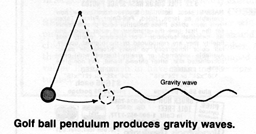 Any object, be it a golf ball or the earth, produces a gravitational attraction which is proportional to its mass, the larger the mass the larger the attraction. If a golf ball is suspended on a string and swings back and forth toward you and away, like a pendulum, it produces gravity waves in the sense that when it swings closer to you its gravitational effect is greater than when it swings farther away. Thus, its oscillation results in a variation of the gravitational attraction which fluctuates in a wave-like manner. For the golf ball, however, the strength of the wave is exceedingly small.
Any object, be it a golf ball or the earth, produces a gravitational attraction which is proportional to its mass, the larger the mass the larger the attraction. If a golf ball is suspended on a string and swings back and forth toward you and away, like a pendulum, it produces gravity waves in the sense that when it swings closer to you its gravitational effect is greater than when it swings farther away. Thus, its oscillation results in a variation of the gravitational attraction which fluctuates in a wave-like manner. For the golf ball, however, the strength of the wave is exceedingly small.
The motion of any object produces gravity waves so whenever you move you produce gravity waves; you are a gravity wave transmitter, albeit a very weak one.
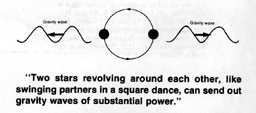 To generate gravity waves of significant strength more massive objects are needed. Thus, for example, two stars, each as massive as our sun, revolving around each other like swinging partners in a square dance, will send out gravity waves of substantial power.* (*The revolving stars constitute a gravitational quadrupole. By contrast, electromagnetic waves can radiate from electric charges oscillating along a straight wire constituting an electric dipole. Gravitational radiation, that is, gravity waves at a large distance from their origin and completely detached from it, cannot be of the dipole type but can be of the quadrupole type.) Likewise, a star with nuclear fuel depleted, which collapses on itself into a pulsar or black hole, will radiate a strong pulse of gravity waves. Although gravity waves are theoretically possible and searches for them have been in progress for some years, none have as yet been detected for sure.
To generate gravity waves of significant strength more massive objects are needed. Thus, for example, two stars, each as massive as our sun, revolving around each other like swinging partners in a square dance, will send out gravity waves of substantial power.* (*The revolving stars constitute a gravitational quadrupole. By contrast, electromagnetic waves can radiate from electric charges oscillating along a straight wire constituting an electric dipole. Gravitational radiation, that is, gravity waves at a large distance from their origin and completely detached from it, cannot be of the dipole type but can be of the quadrupole type.) Likewise, a star with nuclear fuel depleted, which collapses on itself into a pulsar or black hole, will radiate a strong pulse of gravity waves. Although gravity waves are theoretically possible and searches for them have been in progress for some years, none have as yet been detected for sure.
Assuming that as techniques are improved, gravity waves will be detected and, further, that it may be possible to generate sufficiently strong gravity waves under intelligent control to send messages via these waves, could gravity waves become a revolutionary new method for interstellar communication? This intriguing possibility is the subject of an article being prepared for COSMIC SEARCH by Professor David Douglass of the University of Rochester, who has been operating gravity wave detectors for a number of years and is developing new, more sensitive types.
A purpose of this ABCs item on gravity waves is to provide a bit of background in anticipation of Douglass' article.
In an article by Jay Pasachoff and Marc Kutner on "Neutrinos for Interstellar Communication" in the Summer 1979 issue of COSMIC SEARCH, a possible neutrino transmitter and receiver, or communication system, was described on page 6 which might lead to a practical system of the future. Let's look ahead at what might be involved in a system for sending messages with gravity waves, remembering that with gravity waves we are even further from a practical system than we are for neutrinos.
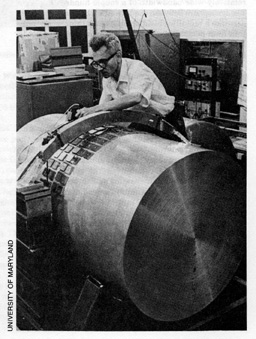 [Caption for Photo to the Left.] Joseph Weber adjusting sensors on his big cylindrical aluminum bar often called a "Weber-bar antenna". The bar is suspended from its mid-point and during observations is enclosed in a sound-proof, shock-proof chamber from which the air is pumped out.
[Caption for Photo to the Left.] Joseph Weber adjusting sensors on his big cylindrical aluminum bar often called a "Weber-bar antenna". The bar is suspended from its mid-point and during observations is enclosed in a sound-proof, shock-proof chamber from which the air is pumped out.
For a receiver we might use a device similar to the basic one developed by Professor Joseph Weber, pioneer gravity-wave scientist, of the University of Maryland, consisting of a large aluminum bar suspended at its mid-point and isolated from atmospheric and vibrational effects by enclosing it in a cushioned, evacuated tank. A passing gravitational wave tends to make the bar vibrate as though tapped by a small hammer. The vibration of the bar generates electrical signals in sensors attached to the bar and these signals are then amplified and recorded.
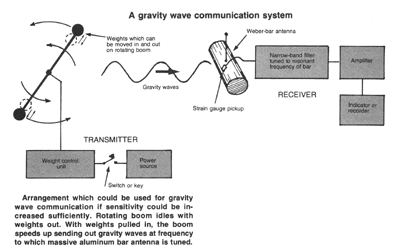 For a transmitter suppose we place a large mass or weight at each end of a long boom which rotates rapidly in a big evacuated tank so that the masses revolve like two riders at opposite sides of a merry-go-round. This arrangement is really a greatly scaled down version of the double star system we talked about earlier.
For a transmitter suppose we place a large mass or weight at each end of a long boom which rotates rapidly in a big evacuated tank so that the masses revolve like two riders at opposite sides of a merry-go-round. This arrangement is really a greatly scaled down version of the double star system we talked about earlier.
If the gravity wave bar-detector or receiver is tuned to a frequency of 1000 cycles per second and the gravity waves sent out by the transmitter are at a considerably lower frequency, there will be little or no signal received. However, if the two weights are moved inward along the boom, their rotation rate will increase, in the same way a pirouetting ice skater speeds up when arms are drawn inward. If the rate now corresponds to a 1000 cycle per second gravity wave, the detector could receive a signal. Thus, by moving the weights in and out, making them spin around faster or slower, we would have a crude frequency shift transmitter for sending code signals. The device for moving the weights in or out could be controlled by a switch or key as in a radio code transmitter.
Although the message sending rate would necessarily need to be very slow and although the gravity waves might be much too weak to be practical, (like 30 or more orders of magnitude too weak) the arrangement illustrates the basic elements required for a gravity wave communication system.
Summary
- Gravity waves are believed to travel at the speed of light.
- In principle, gravity waves could be used for communication purposes.
- A gravity wave communication system is, at present, further from practical realization than, for example, a neutrino communication system.
B. The Solar System Signature. How Our Solar System Would Appear to an Observer at a Distant Star
Although the sun is the largest object and the principal source of radiation from the solar system, two of the planets, Jupiter and the earth, also contribute. While the sun is strongest at optical wavelengths, Jupiter and the earth are radio emitters.
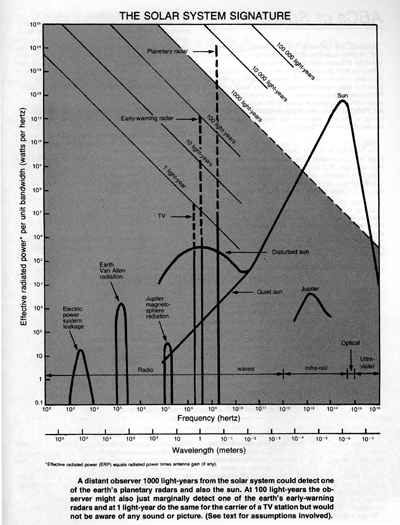 For an overall view of the radiation from the solar system as it might appear from a distant star, let us make a graph of the power radiated (per unit bandwidth) versus the frequency as done in the accompanying Solar System Signature or spectrum.
For an overall view of the radiation from the solar system as it might appear from a distant star, let us make a graph of the power radiated (per unit bandwidth) versus the frequency as done in the accompanying Solar System Signature or spectrum.
At the lower left of the "signature" is a small peak at a few kilohertz (103 to 104 hertz) due to leakage from the earth's open wire electric power distribution lines. Higher harmonics of the 60 hertz currents penetrate the earth's ionosphere and in the magnetosphere or Van Allen region are amplified as much as 1000-fold by wave-particle interactions.* (*C. G. Park and R. A. Helliwell, Science, May 19, 1978.)
A larger peak at 200 kilohertz (1500 meters wavelength) is from radio waves generated by fast particles in the Van Allen belts. The power level fluctuates, being associated at times with auroral (northern or southern) light activity. The total power from this radiation source sometimes amounts to a billion watts. The peak would be higher if it weren't for the fact that the radiation is spread out over a relatively wide bandwidth of a couple hundred kilohertz. The ionosphere between the Van Allen belts and the earth acts like a metallic shield and prevents this strong radiation from pentrating down to the earth. If it were not for this shielding this Van Allen noise would severly jam the European broadcasts in the long wave radio band.
Still higher in frequency, around 20 megahertz (15 meters wavelength), Jupiter makes itself heard due to radiation from fast particles in its magnetosphere. The radiation appears to be initiated or controlled in some way by Jupiter's small inner moon Io. The total power of this radiation at its maximum is perhaps a billion watts, the same as the earth's Van Allen radiation, but the power per unit bandwidth (chart vertical scale) is less because the bandwidth is greater.
At about this frequency the radio emission from the sun becomes significant even during the relatively quiet periods between sunspot maxima which occur every 11 years. During a spot maximum the radiation may be a thousand times greater and much in excess of the Jupiter radiation, and even enough to mask TV signals from the earth as discussed in the next paragraph.
Next on the "signature" are three tall spikes near 200 megahertz (1.5 meters wavelength), 400 megahertz (75 centimeters wavelength) and 2 gigahertz (15 centimeters wavelength) due to man-made signals from television, military early-warning radar and planetary radar stations. The bandwidths are narrow so the power per unit bandwidth is large. All of these stations use antennas which increase the effective power in certain directions. The solid part of each spike shows the power level if the
power is radiated uniformly in all directions while the dashed extension indicates the increase in effective power due to the antenna.
The television station spike is not due to the modulation which produces the picture but to the very narrow bandwidth carrier (less than 1 hertz bandwidth) which is the backbone of the signal. Sullivan, Brown and Wetherill† († Science, Jan. 27, 1978.) have pointed out that although an Arecibo system might detect a television carrier at a distance of a light-year or so, "ten thousand times more sensitivity would be required to obtain program material."
The most intense signals from the earth are from planetary radar stations which bounce radio waves off the moon, Venus and Mars. Such stations are located at Arecibo in Puerto Rico, Jodrell Bank in England, Goldstone in California and elsewhere. These radar stations may transmit with very narrow bandwidth. Since much of the effective power results from the large antenna used (dashed part of the spike), this means that the direction in which a strong signal is transmitted is very limited in angular extent, as in a very narrow searchlight beam, so even though the signal is strong the chances of it being picked up
by an observer at another star is very small.
The world's AM broadcasting stations, including the most powerful ones of several million watts in Saudi Arabia, are confined in coverage to the earth by the ionosphere, and while the FM stations' frequencies are high enough to penetrate the ionosphere, they are not powerful enough to be contenders.
As we go to still higher frequencies on the "signature" the radio, infra-red, optical and ultra-violet radiation from the sun becomes dominant.
Now suppose you live on a planet revolving around a star 1000 light-years from our sun. At this distance the solar system out to the orbit of the planet Pluto subtends an angle like that of a penny seen from a distance of 10 miles so when you point your radio telescope at the sun you also have the planets in the beam and observe the whole solar system as single entity. Suppose your radio telescope has 100 times the sensitivity of Arecibo (such as a large orbiting telescope now under consideration) and also you have a sizable optical telescope (the sun would be too faint to be seen by unaided eye at 1000 light-years).
Referring to the "signature" you could detect everything projecting above the line marked 1000 light-years or the sun and a planetary radar. Things below (shaded) would be too weak or, as communication engineers would say, "buried in the noise". If you were at 10,000 light-years only the sun could be detected (above line marked 10,000 light-years). On the other hand, at 100 light-years an early warning radar station could just be detected but even at the relatively close-up distance of one light-year a TV station would not yet be detectable, and the Van Allen, Jupiter and earth power line radiation would also be too weak.
Although our discussion has been greatly oversimplified* (*We have assumed that the receiver bandwidth matches that of the transmitter or source and that the bandwidth-time-constant product of the receiver is unity. Other factors affecting the results are sky background temperature, wavelength and signal-to-noise ratio (assumed equal to 10). With somewhat different assumptions, ranges could easily change by a factor of 10 or more.), it gives some idea of how far radiation could be detected for different solar system sources.
Suppose that at your distant star you had detected a planetary radar signal from the earth, would you associate it with a technological civilization in the solar system? Perhaps not unless you could study it for some time. If the radar were being beamed at one of the sun's planets, it is not likely you would have this opportunity because as the planet moves with respect to the stars the beam would wander off from your direction.
We have discussed how communication at 1000 light-years could be possible with technology we now have or soon may have. But what kind of communication?
We have assumed a receiver time constant of 10 seconds so it would take about a minute for a dot and longer for a dash. This means it could take an hour or so to just to say "Hello". There could be no speech, no music, no TV, just slow dots and dashes—a rudimentary Morse code communication like Marconi's first three dots across the Atlantic in 1903. And there would also be a 1000 year delay so a good question would be whether the civilization which sent the signals still existed. The signals could only tell you that there was a technological civilization in the solar system 1000 years before. Could the signals, you might ask, be artifacts of a vanished society—electromagnetic relics from antiquity rushing through space at the speed of light?
Summary:
- The sun dominates the solar system signature from radio wavelengths through infra-red, optical and into the ultra-violet.
- The natural radio emissions from Jupiter's magnetosphere and the earth's Van Allen regions are part of the solar system signature.
- Protracted extremely narrow-bandwidth observations of the sun from another star might result in the discovery of terrestrial radar transmissions but these might not be recognized as being produced by a technological civilization, at least not initially.
- The chances of the very narrow beam from a planetary radar being detected at random are very small.
- Radiation from the earth's electric power distribution lines penetrates the ionosphere and is radiated but it is not as strong as other sources.
- Although the carrier of a TV station might be detectable at light-year distances, the recognition of any program is unlikely.

|
![[NAAPO Logo]](../../Images/NAAPOsm.jpg)
![[NAAPO Logo]](../../Images/NAAPOsm.jpg)